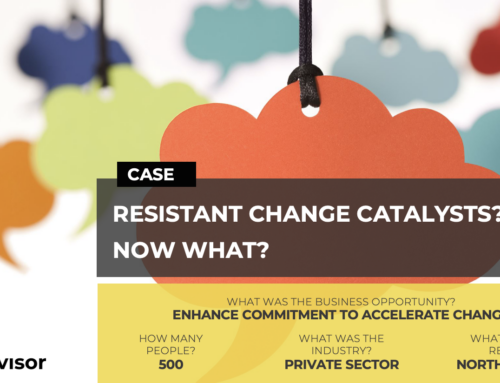SUCCEED WITH CHANGE & TRANSFORMATION
Change Through Peer to Peer Influence
January 1st, 2018 | Change
The economic meltdown had hit the company hard. Agreed investments from its biggest clients had been stalled, and the outlooks were not good. Simultaneously, competition from China had suddenly stepped up – not only in China… but in all of its biggest markets.
It was fair to say that leadership had been too slow to adapt the organization to the changes in its environment.
One year earlier…
Just one year earlier, “the sky was the limit”, and the CEO had been bullish in his communication to the media. Decision power was increasingly decentralized and empowerment was widespread, even for bigger decisions like the opening of satellite offices.
Structures and policies were not in place – and basic internal communication channels such as companywide e-mail were not working.
New employees were on-boarded in volumes. If those new employees required certain conditions and fringes, they did not hear a “No!”. If it felt impossible or too time-consuming to find a qualified employee, it was ok all the way down to the people manager level to hire a consultant as a substitute.
The need for a hard stop was evident
It became evident for the leadership that it had to hit a hard stop and get back in control of the company. Survival was in play, and the deadline was clear. The company had ten months to transform.
What is peer-to-peer influence?
In recent years internal communications functions have started focusing more on working with peers to achieve impact. These were sometimes nicknamed ‘influencers’, in other cases ‘ambassadors’, or even the ‘voice of the people’. The objective was always to mobilize and engage the organization.

There are many arguments for this approach:
- Emotions are contagious: All emotions are contagious, and they spread like a virus from person to person. Example: People who have direct contact with a happy person are fifteen percent more likely to be happy. People that are two relations away from a happy person are ten percent more likely to be happy.
- Likability beats competence in networks: Being likable beats being competent in networks. If people have a choice between a competent jerk and a lovable fool, then most people will network with the lovable fool. This dynamic also applies to organizations. One caveat though is that managers are more likely to go to the competent jerk, whereas almost all employees will go to the lovable fool.
- Some employees are ten times more influential than others: The most influential employees are typically ten times as influential as the average employee, and twenty percent of employees have only limited or no influence. If you want to know who those influential people are, then watch who it is that people seek out in your canteen to have lunch with or go to for sense-making.
What has made peer-to-peer so important?
With the above knowledge and a bit of help from Keynes’ economic theory, we can calculate where companies will get the most value out of a dollar invested. Is a broad-focused internal communications campaign, or a focused effort on a group of influential employees? The facts are clear. One dollar invested in a focused effort on a group of influential employees has a five times higher return than a broad investment.
But this is not the only reason why it matters to work with a peer-to-peer influence. The business environment is also rapidly changing as globalization and digitalization gain importance. Suddenly the majority of the work inside companies is not happening inside the boxes in the org chart, but outside and across the organization. CEB claims the number has increased from ten percent of employees primarily working outside their own box in the org chart in 2005 to ninety percent in 2015.
Why does it matter to work with peer-to-peer influence?
There are three recent findings that support the importance of working with peer to peer influence or the so-called ‘water cooler conversations’:
- Peers are the trusted resource: The Edelman Trust Barometer for 2017 found that trust in peers rose to above 60% while trust in executives is below 38% across the 28 countries surveyed.
- Peer credibility decides if a message gets noticed: The American Press Institute survey found that peer credibility is decisive in whether a message gets noticed or believed.
- Three percent drive perceptions of others: Innovisor research shows that three percent of all employees drive the perceptions of their peers. When they are positive around a topic, they drag the perceptions of everybody else in the positive direction, and when they are negative, they do the opposite.
The three percent are therefore the employees in your organization you must engage and mobilize if you want to succeed.
How to work with influencers?
So how can I work with those with influence when I have identified them and can I just forget all my other traditional communication efforts? Let me answer the last question first. No, you cannot forget your traditional communication efforts.
Leaders are still of paramount importance. They need to formulate and communicate the “Why” in a precise and engaging manner. In the leadership meetings, in the town hall meetings, on the intranet – and through all the usual corporate communication channels.
Leaders also must be role models. If the organization has a safety focus, then the leader needs to be the first to adhere to these principles. If it is a collaboration-program, the leaders need to demonstrate collaborative behavior, and if it is a diversity and inclusion program it is about being authentically inclusive.

But how about managing about peer to peer influencers? There are different ways you can engage with them, but try to keep the conversations informal. Let the influencers understand what is going on in the organization, let them ask questions, and even allow them to alter something here and there. Then they will be your most powerful advocates out there at the water cooler and facilitate the sense-making of all their colleagues. And don’t forget that there is always a need to set up a governance structure and for regular trustful conversations with your influencers. You will also need a tracking mechanism to understand their perceptions and measure their level of engagement.
So how did the manufacturing company fare?
The manufacturing company identified a group of +50 important employees, mobilized them, and engaged them. Executive leadership had a series of conversations with the group, but also one-on-ones, where they tested ideas, plans, and messages before they were shared with the rest of the organization.
A closed virtual discussion forum was also established where sensitive issues could be discussed. The company also tracked (through what they called their Early Warning system) how the perceptions of the group slowly, steadily changed from being negative/neutral to very positive and actively involved in saving the company. At the onset of the project, the company was completely off track. Tens of months later the successful transformation was a fact. Today, the manufacturing company is back in its position as the global market leader in its segment.
Sources:
Edelman Trust Barometer (2017)
Lalleman, R. (2017): “How to Rethink Change with the Three Percent Rule”, Analytics in HR – https://www.analyticsinhr.com/blog/rethink-change-three-percent-rule/
Christiakis, N. & Fowler, J. (2009): “Connected”, Little, Brown & Co., New York, NY, U.S.A.
Casciaro, T. & Lobo, M.S. (2005): “Competent Jerks, Lovable Fools, and the Formation of Social Networks”, Harvard Business Review, Boston, M.A., U.S.A.
Maurer, R. (2010): “Beyond the Wall of Resistance”, Bard Press, Austin, TX, U.S.A.
ORIGINALLY POSTED ON Science For PR: http://scienceforpr.com/case-study-change-through-peer-peer-influence/
CHANGE
Change Through Peer to Peer Influence
January 1st, 2018 | Change

The economic meltdown had hit the company hard. Agreed investments from its biggest clients had been stalled, and the outlooks were not good. Simultaneously, competition from China had suddenly stepped up – not only in China… but in all of its biggest markets.
It was fair to say that leadership had been too slow to adapt the organization to the changes in its environment.
One year earlier…
Just one year earlier, “the sky was the limit”, and the CEO had been bullish in his communication to the media. Decision power was increasingly decentralized and empowerment was widespread, even for bigger decisions like the opening of satellite offices.
Structures and policies were not in place – and basic internal communication channels such as companywide e-mail were not working.
New employees were on-boarded in volumes. If those new employees required certain conditions and fringes, they did not hear a “No!”. If it felt impossible or too time-consuming to find a qualified employee, it was ok all the way down to the people manager level to hire a consultant as a substitute.
The need for a hard stop was evident
It became evident for the leadership that it had to hit a hard stop and get back in control of the company. Survival was in play, and the deadline was clear. The company had ten months to transform.
What is peer-to-peer influence?
In recent years internal communications functions have started focusing more on working with peers to achieve impact. These were sometimes nicknamed ‘influencers’, in other cases ‘ambassadors’, or even the ‘voice of the people’. The objective was always to mobilize and engage the organization.

There are many arguments for this approach:
- Emotions are contagious: All emotions are contagious, and they spread like a virus from person to person. Example: People who have direct contact with a happy person are fifteen percent more likely to be happy. People that are two relations away from a happy person are ten percent more likely to be happy.
- Likability beats competence in networks: Being likable beats being competent in networks. If people have a choice between a competent jerk and a lovable fool, then most people will network with the lovable fool. This dynamic also applies to organizations. One caveat though is that managers are more likely to go to the competent jerk, whereas almost all employees will go to the lovable fool.
- Some employees are ten times more influential than others: The most influential employees are typically ten times as influential as the average employee, and twenty percent of employees have only limited or no influence. If you want to know who those influential people are, then watch who it is that people seek out in your canteen to have lunch with or go to for sense-making.
What has made peer-to-peer so important?
With the above knowledge and a bit of help from Keynes’ economic theory, we can calculate where companies will get the most value out of a dollar invested. Is a broad-focused internal communications campaign, or a focused effort on a group of influential employees? The facts are clear. One dollar invested in a focused effort on a group of influential employees has a five times higher return than a broad investment.
But this is not the only reason why it matters to work with a peer-to-peer influence. The business environment is also rapidly changing as globalization and digitalization gain importance. Suddenly the majority of the work inside companies is not happening inside the boxes in the org chart, but outside and across the organization. CEB claims the number has increased from ten percent of employees primarily working outside their own box in the org chart in 2005 to ninety percent in 2015.
Why does it matter to work with peer-to-peer influence?
There are three recent findings that support the importance of working with peer to peer influence or the so-called ‘water cooler conversations’:
- Peers are the trusted resource: The Edelman Trust Barometer for 2017 found that trust in peers rose to above 60% while trust in executives is below 38% across the 28 countries surveyed.
- Peer credibility decides if a message gets noticed: The American Press Institute survey found that peer credibility is decisive in whether a message gets noticed or believed.
- Three percent drive perceptions of others: Innovisor research shows that three percent of all employees drive the perceptions of their peers. When they are positive around a topic, they drag the perceptions of everybody else in the positive direction, and when they are negative, they do the opposite.
The three percent are therefore the employees in your organization you must engage and mobilize if you want to succeed.
How to work with influencers?
So how can I work with those with influence when I have identified them and can I just forget all my other traditional communication efforts? Let me answer the last question first. No, you cannot forget your traditional communication efforts.
Leaders are still of paramount importance. They need to formulate and communicate the “Why” in a precise and engaging manner. In the leadership meetings, in the town hall meetings, on the intranet – and through all the usual corporate communication channels.
Leaders also must be role models. If the organization has a safety focus, then the leader needs to be the first to adhere to these principles. If it is a collaboration-program, the leaders need to demonstrate collaborative behavior, and if it is a diversity and inclusion program it is about being authentically inclusive.

But how about managing about peer to peer influencers? There are different ways you can engage with them, but try to keep the conversations informal. Let the influencers understand what is going on in the organization, let them ask questions, and even allow them to alter something here and there. Then they will be your most powerful advocates out there at the water cooler and facilitate the sense-making of all their colleagues. And don’t forget that there is always a need to set up a governance structure and for regular trustful conversations with your influencers. You will also need a tracking mechanism to understand their perceptions and measure their level of engagement.
So how did the manufacturing company fare?
The manufacturing company identified a group of +50 important employees, mobilized them, and engaged them. Executive leadership had a series of conversations with the group, but also one-on-ones, where they tested ideas, plans, and messages before they were shared with the rest of the organization.
A closed virtual discussion forum was also established where sensitive issues could be discussed. The company also tracked (through what they called their Early Warning system) how the perceptions of the group slowly, steadily changed from being negative/neutral to very positive and actively involved in saving the company. At the onset of the project, the company was completely off track. Tens of months later the successful transformation was a fact. Today, the manufacturing company is back in its position as the global market leader in its segment.
Sources:
Edelman Trust Barometer (2017)
Lalleman, R. (2017): “How to Rethink Change with the Three Percent Rule”, Analytics in HR – https://www.analyticsinhr.com/blog/rethink-change-three-percent-rule/
Christiakis, N. & Fowler, J. (2009): “Connected”, Little, Brown & Co., New York, NY, U.S.A.
Casciaro, T. & Lobo, M.S. (2005): “Competent Jerks, Lovable Fools, and the Formation of Social Networks”, Harvard Business Review, Boston, M.A., U.S.A.
Maurer, R. (2010): “Beyond the Wall of Resistance”, Bard Press, Austin, TX, U.S.A.
ORIGINALLY POSTED ON Science For PR: http://scienceforpr.com/case-study-change-through-peer-peer-influence/
Related articles
Share article
Share article







